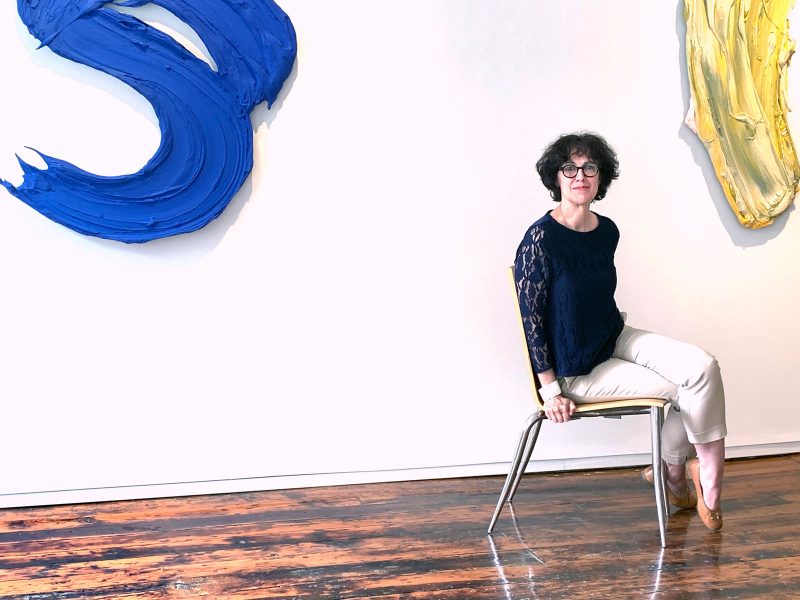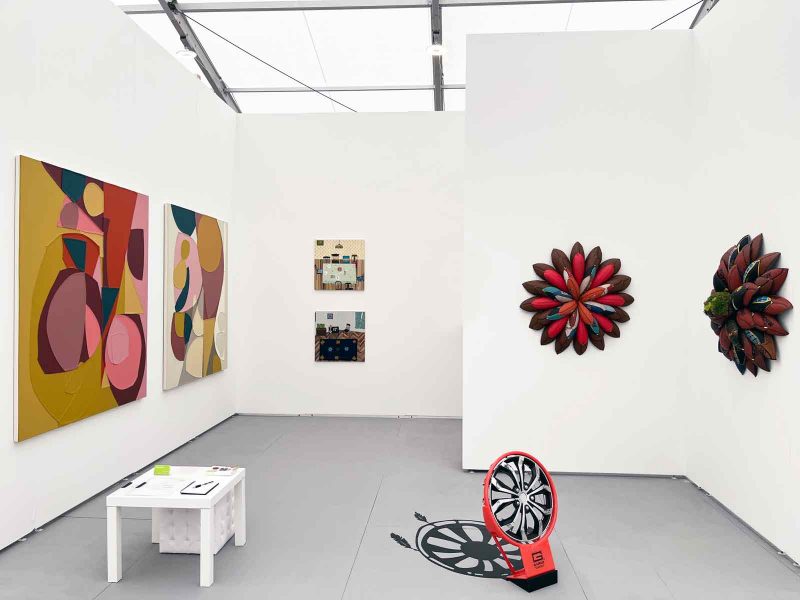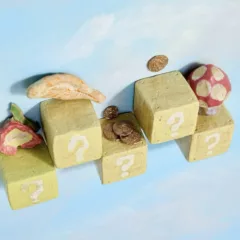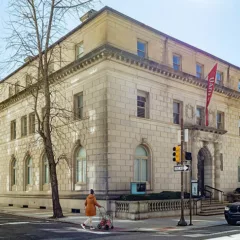
Elizabeth Johnson sits down for an interview with Christine Pfister of Pentimenti Gallery and learns about what fuels the Swiss-born gallerist’s business: love of art, love of artists, dedication to being around in the future, and a good business plan that includes buying the gallery’s building on 2nd Street in Old City. The interview was edited for length and clarity.
Why did you name the gallery Pentimenti?
My husband named and opened the gallery in 1992 as a side business, before we met. Pentimenti is a metaphor: it is the plural of pentimento, or changes made by the artist during the process of painting. These changes are usually hidden beneath paint layers. Sometimes the topmost paint layers become transparent with time and pentimenti are revealed. The name speaks to the gallery’s support and service that is usually hidden beneath the artist’s success, and which in some instances, will become apparent with time. We got married in 1995, and I took over after his second gallery director stepped down. The gallery wasn’t making money. I told him I would try it for six months and warned him that I would maybe change my mind. I was realistic about the difficulties of running a gallery.
During the Pandemic lockdown you promoted Pentimenti Warehouse, a project that encouraged sales of works that your artists might have in storage–smaller or more affordable pieces that are important but had not been exhibited in the gallery. Can you talk about this project?
We began setting up Pentimenti Warehouse two years before the pandemic struck, so the time off from normal gallery business allowed us to perfect the platform, choose, label and upload work. The project allowed us to engage new, younger collectors that perhaps like the work of a certain artist, but can’t afford to spend thousands. It also kept us in touch with our artists. Some of our artists sold a lot of smaller works during this time, some made pieces especially for the project.
After thirty years at Pentimenti you seem as committed to the gallery as an artist is committed to their craft. I read that most galleries are open 2.5 years. How have you managed to survive when the odds are against you?
A gallery is just like any other business. But at Pentimenti my chief responsibility is to serve my artists. I program twenty established artists and regularly introduce emerging guest artists. I am very organized and carefully plan my calendar. I work with one full-time assistant, and subcontract shipping and installation to people I know and trust. We survive by selling work. I am committed to the Old City art community.
When you and Becky Kerlin of Gallery Joe were last interviewed by Artblog in 2012, you mentioned that you were lucky to own your building. Do you still consider owning a brick-and-mortar space the best option compared to renting?
Owning a space is not for everybody. I was happy renting for many years, though I had to pay for every repair. Buying property after I took over Pentimenti in 1996 was originally our Plan B, but it proved to be the most realistic choice. I am still paying the mortgage on this space, and there are numerous taxes: Real Estate tax, an Old City tax, Use of Occupancy tax, and special trash expenses for the neighborhood. I pay all the repairs and services for my building. I worry that there are empty storefronts in the neighborhood now after Covid, but hopefully those will rent to new businesses.
NextFab, the Clay Studio, Larry Becker, Gallery Joe, Roger LaPelle, Painted Bride and other galleries have moved or closed. Do you see less foot traffic due to fewer galleries in the neighborhood?
I was trained as a statistician, so I am inclined to keep the numbers on foot traffic. Between 2020 and 2021, foot traffic doubled to the gallery. I attribute that to people rediscovering Philadelphia when they couldn’t travel long distances. So far in 2022, foot traffic is on par with numbers before the pandemic, and there were some Saturdays that we were not open this year. It is true that NextFab, the Clay Studio and Painted Bride moved. Larry Becker is open by appointment. Unfortunately, Roger LaPelle died. And Gallery Joe closed, but Becky was ready to let it go. Old City has gone from twenty-six to fourteen galleries, but it is still a major art hub. I count the galleries around Washington Square as part of Old City. Philadelphia has become a place of multiple art neighborhoods. Spaces are cheaper to rent or buy up on North American Street. You probably need a car to visit Fishtown and Northern Liberties. I had a collector who stayed recently in Rittenhouse square; he walked to the Philadelphia Art Museum, through Old City to the Cherry Street Pier and stopped at Pentimenti on his way. Being on the path to the Cherry Street Pier attracts a lot of foot traffic to us.
Do you still have a masking policy? And how did you decide on it given peoples’ diverse opinions?
Lately, if a visitor walks in with a mask, I mask up. If they walk in without one I am careful to keep a six foot distance. Before, when there was more of a Covid threat I was masked more often. I leave it up to the visitor.
In the 2012 Artblog interview you said that internet sales are booming. Is this still the case?
Yes, and I have learned how interconnected online sales and fairs have become. It is so helpful if internet collectors can meet us and see work in person.
Do you do art fairs each year?
I usually do Untitled Art, in Miami, in the winter, and Future Fair in spring: two a year. I was accepted in a Chicago fair this year but ended up not going since I wanted to attend my son’s graduation. To apply to a fair, you submit a proposal for review, and if accepted have only four to five months to plan. And it’s often the case that if you are accepted one year, they don’t want you the next. Art fairs really serve my artists, and sometimes I only sell enough to cover my expenses, but they give credibility to the roster I am showing. Curators are like kids in the candy store. And other gallerists that might help my artists’ careers are shopping fresh talent. Most importantly, I get to meet our online collectors at fairs.

Were your internet sales consistent throughout the pandemic when no art fairs were happening? And are you feeling the anticipated recession?
We are always working on behind-the-scenes projects that cultivate sales and the public doesn’t know about. Some projects I work on require a twenty-four-hour response. So, I would say that since we work on promotion before, during and after financial crises, that we are generally OK. Taking a long-term approach lessens the effect of financial downturns but can’t erase them entirely.
How do you focus the programming of Pentimenti?
Many of my artists have a Philadelphia connection. Maybe they came to study here and stayed. They are good enough to make it in New York, but New York is too expensive. I have Donald Martiny and Kay Seohyung Lee exhibiting now, two artists with very different styles. Donald is on my roster and Kay is a guest artist. During the installation, I relate the two bodies of work by theme or color. Every June I do an open call to source guest artists. From a list of possible guest artists, I fill gaps in my regular programming and try out new talent.
How do you choose guest artists? And can you describe your aesthetic?
Trust me, I love everything––that’s my problem! But my gallery has an identity that I follow. I need to be able to talk about the work I represent. I pick work that is abstract, a bit conceptual, outside realism, though with Kay, for instance, there is representation. And Anne Buckwalter is representative. So, you could say my taste is expanding. Right now, I am curious about realism that gets the perspective wrong or seems surrealistic. But in general, I like artwork that is attentive to craftsmanship, format, and materials.
Do you have guidelines for your artists?
When I first approach them and we are discussing working together, I tell them to call any one of my artists and talk to them about me. I tell them, “Don’t tell me about your conversation.” I don’t want to know what is said, but it might help you to get a recommendation from another artist as an introduction to the gallery.
You grew up and studied in Switzerland. Did you study art or plan a career in the arts?
I got a four-year liberal arts degree, and I did make watercolors. Like every other corner of Europe, Switzerland is steeped in art, and many art classes made museum-going mandatory. On spring vacations from college, I traveled to Florence with my friend Corinne Gotti, who is now an art history and Italian professor. We roamed nonstop, morning to evening, and I owe much of my art education to her. The architectural statistics job I got in the US was flexible enough that I could travel and get a Swiss Business Certificate, that is similar to a MBA.
It was serendipitous to have a business background. Did you have mentors?
I also got a Certificate of Contemporary and Decorative art from Christie’s in New York. As an overview the course included: looking at art and living with it at home, sales, provenance, behind the scenes practices, art materials, and processes. I had a good relationship with the former gallery director at Pentimenti: we worked together and went on studio visits together. I learned a lot on the job.
Do you have a vision or philosophy for the gallery?
I’m a people person, I focus on long-term relationships. I am a gallerist as opposed to a dealer. Dealers don’t necessarily have a space. In the beginning I showed emerging artists, now I focus on mid-career artists. I support my artists as they build their careers, I want them to show in other galleries and museums. [Even though selling work is how we survive,] I only show what I love, I don’t care if I can’t sell the work. One artist that I am thinking of had three solo shows in my gallery but sold maybe one work in six years: that is, we had one sale during three exhibitions, and sold nothing to collectors that I work with in between. But I didn’t give up on him: I knew the work was good, and eventually people did take notice. After nine years I was selling a piece of his every month. It was a bizarre experience, but the collectors woke up. I also make it a habit to buy a piece from each of my artists myself.
How do you feel about press coverage for the arts in Philadelphia?
There is not enough press coverage for the arts in the city, there is a feeling of fragmentation here. Philadelphia-based dosage MAGAZINE has covered us, but it ranges into fashion, music, and food as well as art. I get most of my press by blogs and magazines from outside Philadelphia. BmoreArt is based in Baltimore but does pieces about Pentimenti. Our recent Future Fair entry, Anne Buckwalter, was featured in Casey Lesser’s Artsy piece, “The Best Booths at New York Art Week 2022.”
What is your long-term goal?
I am definitely here to stay. There’s a lot of change with artists. Some are ready to move up the ladder, and I encourage them to do so. I try to help them get placed in museums and collections. My long-term goal is holistic: I need to build an ecosystem that connects me, my artists, museum curators, writers, critics, and collectors. I am continually surprised by the depth of knowledge and bravery of my collectors. I am Philadelphia-based, but I am also international. I am in awe of the network that can be built.









